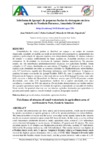Please use this identifier to cite or link to this item:
http://www.alice.cnptia.embrapa.br/alice/handle/doc/941739| Title: | Ictiofauna de igarapés de pequenas bacias de drenagem em área agrícola do Nordeste Paraense, Amazônia Oriental. |
| Authors: | CORRÊA, J. M.  GERHARD, P.   FIGUEIREDO, R. de O.   |
| Affiliation: | JEAN MICHEL CORRÊA, UFPA; PEDRO GERHARD, CPATU; RICARDO DE OLIVEIRA FIGUEIREDO, CNPMA. |
| Date Issued: | 2012 |
| Citation: | Revista Ambiente & Água, Taubaté, v. 7, n. 2, p. 214-230, 2012. |
| Description: | Resumo: Comunidades de peixes podem se distribuir no espaço e no tempo de maneira organizada, seguindo um padrão que pode ser percebido pela associação ou agrupamento das espécies e pela relação de algumas espécies com determinados habitats. O número reduzido de estudos e o pouco conhecimento da fauna aquática na Amazônia resultam em sub-estimativas da diversidade da ictiofauna de igarapés (riachos amazônicos). No presente estudo, em três microbacias predominantemente ocupadas por agricultura familiar, foram coletados 2.117 peixes, distribuídos em sete ordens, 13 famílias, 27 gêneros e 43 espécies. A espécie mais abundante em todas as amostras coletadas foi Hyphessobrycon heterorhabdus, com 337 indivíduos, seguido por Bryconops melanurus, com 326 indivíduos. A riqueza de espécies foi maior num trecho do Igarapé Pachibá (IGPA-B), com 21 espécies. O Índice de Dominância de Simpson mostrou o valor mais alto no trecho B do Igarapé Cumaru, com valor 0,43, enquanto o Índice de Diversidade de Shannon revelou que o IGPA-B possuiu a maior diversidade, com valor 2,39. Iguanodectes rachovii foi a espécie amostrada com mais constância, e ocorreu em 50% das amostras. Os resultados demonstraram que trechos médios dos igarapés apresentam maior diversidade de espécies, respondendo ao tamanho do habitat. Neste estudo foi possível observar que microbacias agrícolas dominadas por agricultura de pequeno porte pode suportar uma diversidade de peixes de igarapés razoável. Abstract: Stream fish communities can show spatial and temporal patterns, which can be revealed by species association or species groups as well as by species preference to certain habitats. The reduced number of studies and the scarce knowledge on the aquatic fauna in the Amazon results on an under-estimative upon stream fish fauna diversity. In this study, a survey at three small Amazonian catchments located in family agriculture areas, a total of 2,117 individuals were collected, belonging to seven orders, 13 families, 27 genera and 43 species. The most abundant species in all samples was Hyphessobrycon heterorhabdus, totaling 337 individuals, followed by Bryconops melanurus, with 326 individuals. The species richness was highest in a Pachibá stream reach, with 21 species. Simpson’s diversity index in a Cumaru stream reach showed the highest species dominance with a value of 0.43, while Shannon’s diversity index showed that the Pachibá stream lowest reach, had the greatest diversity with a value of 2.39. Iguanodectes rachovii was the most constant species, occurring in 50% of samples. Therefore, as a response to habitat size, the intermediate stream reaches presented the highest species diversity. Our study showed that agricultural catchments dominated by smallholder farmers can bear a reasonable stream fish diversity. |
| Thesagro: | Peixe de água doce Microbacia Biodiversidade Agricultura Familiar |
| Keywords: | Peixes de riachos Diversidade |
| Type of Material: | Artigo de periódico |
| Access: | openAccess |
| Appears in Collections: | Artigo em periódico indexado (CNPMA)  |
Files in This Item:
| File | Description | Size | Format | |
|---|---|---|---|---|
| 2012AP41.pdf | 1,02 MB | Adobe PDF |  View/Open |









